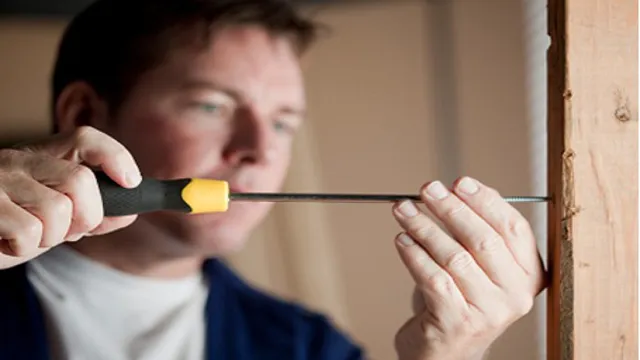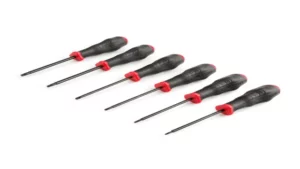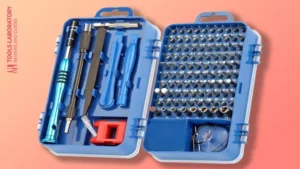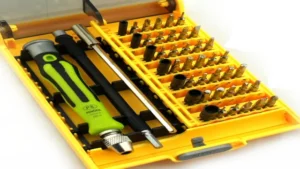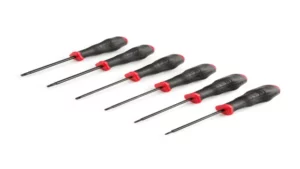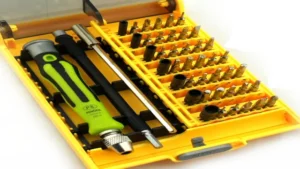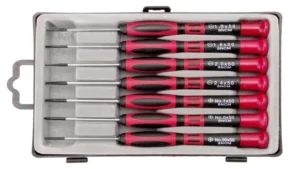Are you a beginner in the world of DIY and home repairs? Feeling overwhelmed by the sheer variety of screwdrivers out there and unsure where to start? Fear not, for this guide is here to help you navigate the confusing landscape of screwdriver sets and get you on the right track to fixing up your house or furniture. Screwdrivers are one of the most versatile and essential tools in a handyman’s toolkit, but knowing which one to use for a specific task can be daunting. Thankfully, with a little knowledge and practice, you can become a pro in no time.
So, grab your screwdriver set and let’s dive in!
Step 1: Know Your Screwdriver Types
If you’re wondering how to use a screwdriver set, the first step is to get familiar with the different types of screwdrivers. There are flathead screwdrivers, which have a single flat blade, and Phillips screwdrivers, which have a four-star-shaped tip. Additionally, there are other types, such as Torx and Robertson screwdrivers, that are less commonly used but still require knowledge and usage.
Each screwdriver type has its own unique use and application in a variety of different settings, so it’s important to have a good understanding of which screwdriver you need before you get started on any project. By knowing your screwdriver types and what they’re used for, you’ll be better equipped to tackle any task at hand and use your screwdriver set with confidence.
Flathead Screwdrivers
Flathead Screwdrivers When it comes to screwdrivers, flathead screwdrivers are one of the most commonly used tools. However, before you can effectively use a flathead screwdriver, it is important to know the different types available. The most common type is the single-slot flathead screwdriver, which features a straight tip and a single horizontal slot in the screw head.
This type is best for screws with larger heads and slots. Another type is the Phillips flathead screwdriver, which features a cross-shaped tip and is designed for use with Phillips head screws. In addition, there are specialty flathead screwdrivers available for specific tasks such as precision work or working with electronics.
Understanding the different types of flathead screwdrivers available will help you choose the right tool for the job and ensure that your work is done correctly.
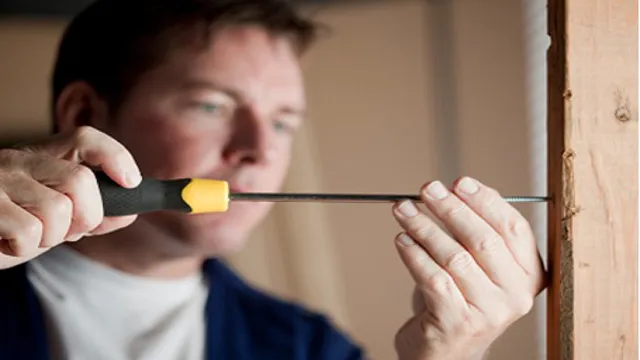
Phillips Screwdrivers
Phillips screwdrivers are essential tools in any DIY kit. However, it’s essential to know the different types of screwdrivers before you start working on a project. Phillips screwdrivers come in different sizes, which can be confusing when choosing the right one.
The sizes range from 0 to 4, with 0 being the smallest and 4 the largest. It’s important to select the screwdriver size that matches the screw head to avoid damaging both the screw and the screwdriver. Another type of screwdriver is the flathead, which is also known as a slotted screwdriver.
This type of screwdriver has a single flat blade and is used for screws with a straight slot head. Both Phillips and flathead screwdrivers should be in your toolkit for any DIY project, so make sure to have a few different sizes of each available. By knowing the different types of screwdrivers and matching them to the correct screw head, you’ll be able to complete your projects efficiently and effectively.
Torx Screwdrivers
If you’re looking to work with Torx screws, the first step is to familiarize yourself with the different types of Torx screwdrivers available. Torx screws are designed with a star-shaped pattern, rather than the traditional Phillips or flathead patterns, and require a matching Torx screwdriver to be tightened or loosened properly. One type of Torx screwdriver is the T-handled driver, which features a comfortable grip that enables you to apply more torque, making it easier to turn difficult screws.
Another type is the L-shaped driver, which comes with a short arm and a long arm, so you can use it in tight spaces or get extra leverage when needed. It’s important to choose the right type of Torx screwdriver for the job at hand, so you can work more efficiently and avoid any damage to your tools or hardware.
Step 2: Choose the Right Screwdriver
When it comes to effectively using a screwdriver set, choosing the right screwdriver is crucial. Using the wrong screwdriver can not only make the job much more difficult but it can also damage the screw itself. The first thing you need to determine is the type of screw you will be working with.
Common types include flathead, Phillips, and Torx. Each requires a specific screwdriver bit to work with. Additionally, you need to consider the size of the screw head as well as the handle of the screwdriver.
A proper fit ensures maximum torque and prevents slippage. Investing in a quality screwdriver set with a variety of sizes and types of screwdriver bits will ensure that you are always prepared for any screwdriving task. By taking the time to choose the right screwdriver for the job, you are guaranteeing a successful outcome without any damage to the material you are working with.
Matching the Screw Head
When it’s time to match the screw head of your project, the next step is choosing the right screwdriver. You don’t want to use a flathead screwdriver for a Phillips head screw, or vice versa. It’s crucial to match the shape of the screw head to the corresponding shape of the screwdriver tip.
Not only will the right screwdriver provide a more secure fit for the screw, but it will also prevent any damage to the screw head or the surrounding surfaces. For example, if you use a Phillips head screwdriver for a flathead screw, you risk stripping the screw head and making it nearly impossible to remove. Always double-check the screw head shape and match it with the corresponding screwdriver tip before attempting to screw anything in.
This small step can make a big difference in the success of your project.
Considering the Size
When it comes to choosing the right screwdriver, the size of the screw is an important factor to consider. Using the wrong size can lead to frustration and potential damage to the screw or other materials. It’s crucial to select a screwdriver that matches the size of the screw head, ensuring a secure and tight fit.
So, before starting any project, take the time to identify the size of the screw and choose the appropriate screwdriver. This small step can make a big difference in the success and longevity of your project. Don’t let a simple mistake like using the wrong screwdriver ruin all of your hard work.
Instead, take the time to consider the size and choose the right tool for the job.
Step 3: Tightening Screws
When it comes to using a screwdriver set, one of the essential steps is tightening screws. After you have inserted the screws into the appropriate holes, it’s time to use your screwdriver to tighten them. A screwdriver set typically includes different types and sizes of screwdrivers, depending on the screws and bolts you need to work with.
To tighten screws, you should place the screwdriver in the screw head, making sure it’s at the correct angle. Gently apply pressure while turning the screwdriver clockwise to tighten the screw. Be careful not to use too much force, or you could strip the screw or damage the surrounding material.
To ensure a secure and stable hold, make sure the screws are tightened but not over-tightened. With practice, using a screwdriver set to tighten screws will become second nature, allowing you to complete DIY projects and repairs around your home easily.
Using a Flathead Screwdriver
Using a flathead screwdriver may seem simple, but there’s a technique to it that makes all the difference. In step three of tightening screws, it’s essential to choose the right size flathead screwdriver for the job. A too small screwdriver will not allow you to apply enough torque, while the wrong size will damage the screw’s head and make it impossible to remove in the future.
Once you have the correct size, insert the screwdriver into the head of the screw, ensuring that it is straight and fully seated in the slot. With firm but gentle pressure, turn the screwdriver clockwise to tighten the screw, taking care not to strip the threads or over-torque the screw. Using a flathead screwdriver correctly will make tightening screws a breeze and ensure your projects are tight, sturdy, and secure.
Using a Phillips Screwdriver
When it comes to using a Phillips screwdriver, one of the most important steps is tightening the screws properly. After inserting the screw into the hole and lining it up with the driver, use steady pressure and turn clockwise to begin tightening. Keep the driver straight and perpendicular to the screw.
As you tighten the screw, make sure it’s neither too tight nor too loose. An overtightened screw can strip the thread or damage the material, while a loose screw won’t hold things securely. One helpful tip is to use your fingertips to feel the resistance, ensuring that you’re not over or undertightening the screw.
Once you’ve reached the right level of tightness, release the pressure and remove the driver from the screw. Always remember to be patient and take your time with each screw, making sure they are tightened to the right level for a secure and long-lasting grip.
Step 4: Loosening Screws
So, you’ve got your screwdriver set handy and you’re ready to loosen those screws. First things first, identify the type of screws you’re working with. Are they Phillips or flathead? Once you know the type, select the correct screwdriver from your set.
Place the tip of the screwdriver securely into the screwhead and gently turn it counterclockwise. Be careful not to apply too much pressure, as this can damage the screwhead, and possibly strip it. If you encounter resistance, stop turning and try tightening the screw slightly before attempting to loosen it again.
This often breaks the seal that’s holding the screw in place, making it easier to remove. Keep the screwdriver straight and steady throughout the process, and make sure to turn it in the correct direction. Before you know it, those stubborn screws will be no match for your trusty screwdriver set!
Using a Flathead Screwdriver
If you’re looking to loosen screws using a flathead screwdriver, follow these simple steps to get the job done. First, make sure you’re using the right size screwdriver for the screws you’re working with. Insert the flathead into the screw head and turn it counterclockwise to loosen.
Apply gentle pressure and use your other hand to hold the object steady. If the screw is stubborn and won’t budge, you can tap the end of the screwdriver with a hammer to help break it loose. Just be careful not to damage the screw or object you’re working on.
Once the screw is loosened, you can remove it completely by hand or with pliers if necessary. And there you have it – loosening screws with a flathead screwdriver is a simple but important skill to have in your toolkit!
Using a Phillips Screwdriver
Phillips screwdriver Now that you’ve positioned the Phillips screwdriver and applied pressure, it’s time to begin loosening the screws. Hold the screwdriver steady and twist it counterclockwise to the left until the screw begins to turn. You may need to press down harder or adjust your grip on the screwdriver to get the screw to move.
It’s essential to apply steady, consistent pressure to prevent stripping the screw or damaging the screw head. If the screw is particularly stubborn, you can try applying lubricant to the screw’s threads or using a larger Phillips screwdriver for more torque. Once the screw starts turning, continue counterclockwise until it comes loose from the material, taking care not to lose it.
Congratulations, you’ve successfully loosened a screw using a Phillips screwdriver.
Conclusion
So there you have it – the ins and outs of using a screwdriver set. With knowledge of the different types of screwdrivers, when and where to use them, and proper handling techniques, you’ll be a pro in no time. And just remember, when in doubt, always make sure to screw it in tight – because a loose screw is never a good thing, whether it’s in furniture or in life.
Happy screwing!”
FAQs
What are the different types of screwdriver heads in a screwdriver set?
A screwdriver set may contain various screwdriver heads such as slotted, Phillips, Torx, Allen, and square.
How to choose the right screwdriver size from a screwdriver set?
The right screwdriver size depends on the size of the screw head. You can match the size of the screw head with the size of the screwdriver head in the set.
Can I use a screwdriver set for other tasks besides tightening screws?
Yes, a screwdriver set can be used for various tasks such as opening paint cans, prying up lids, removing staples, and more.
What is the difference between a manual screwdriver and an electric screwdriver in a screwdriver set?
A manual screwdriver requires manual force and effort to tighten or loosen screws while an electric screwdriver uses a motor to do the job.
How to maintain and care for a screwdriver set?
Keep your screwdriver set clean, dry, and free from rust. Store them in a dry place and lubricate the moving parts occasionally to prevent rust and stiffness.
Is it possible to mix and match different screwdriver heads from different sets?
Yes, as long as they fit the size and type of the screw you’re using, you can mix and match screwdriver heads from different sets.
How to use a screwdriver set safely?
Ensure that the screwdriver head matches the screw size and type properly. Use a secure grip and position yourself in a comfortable posture. Avoid using excessive force and twisting the wrist too much to prevent injuries.
